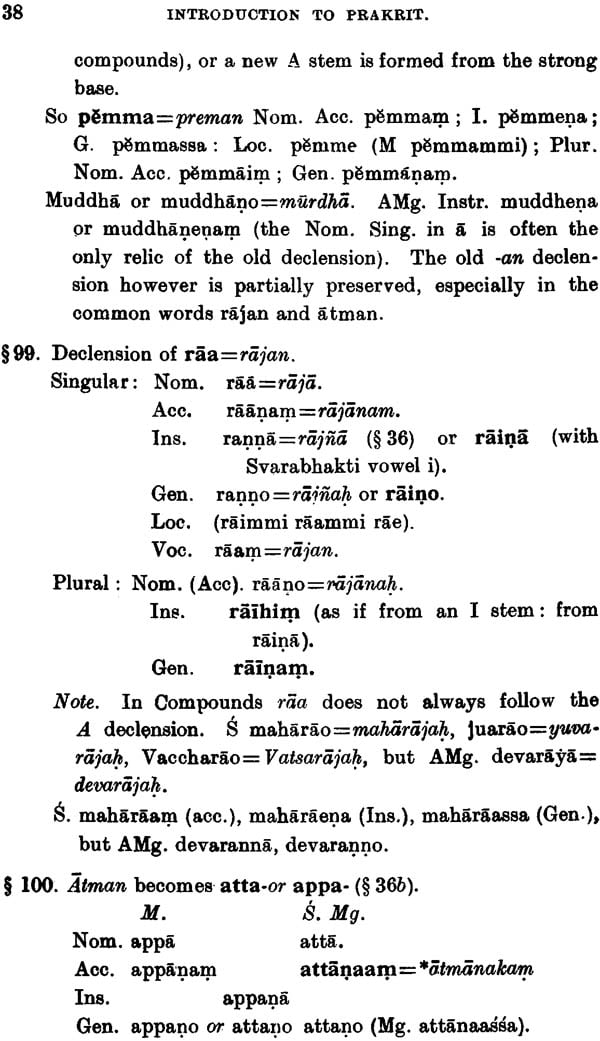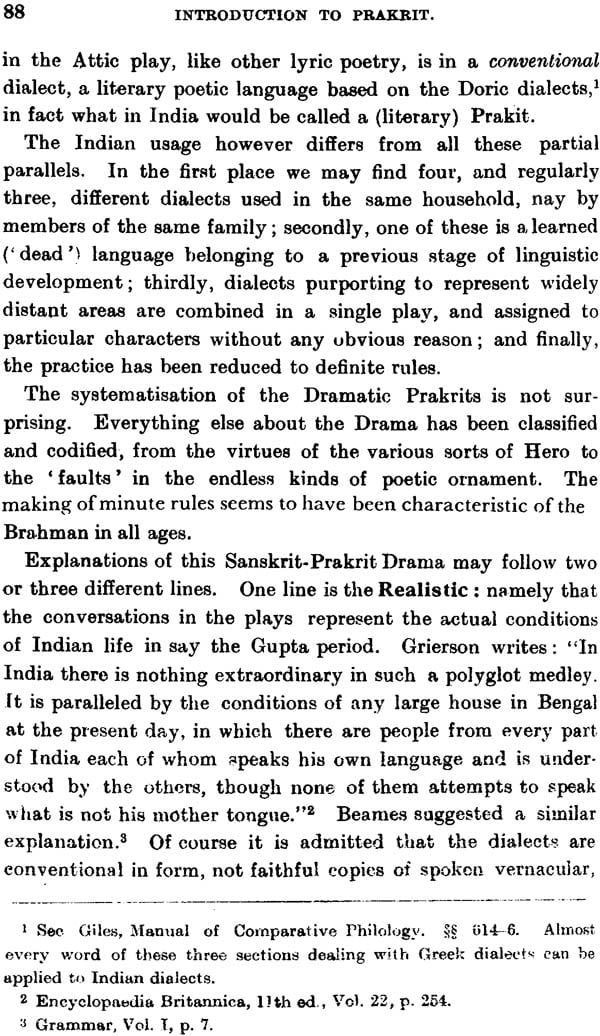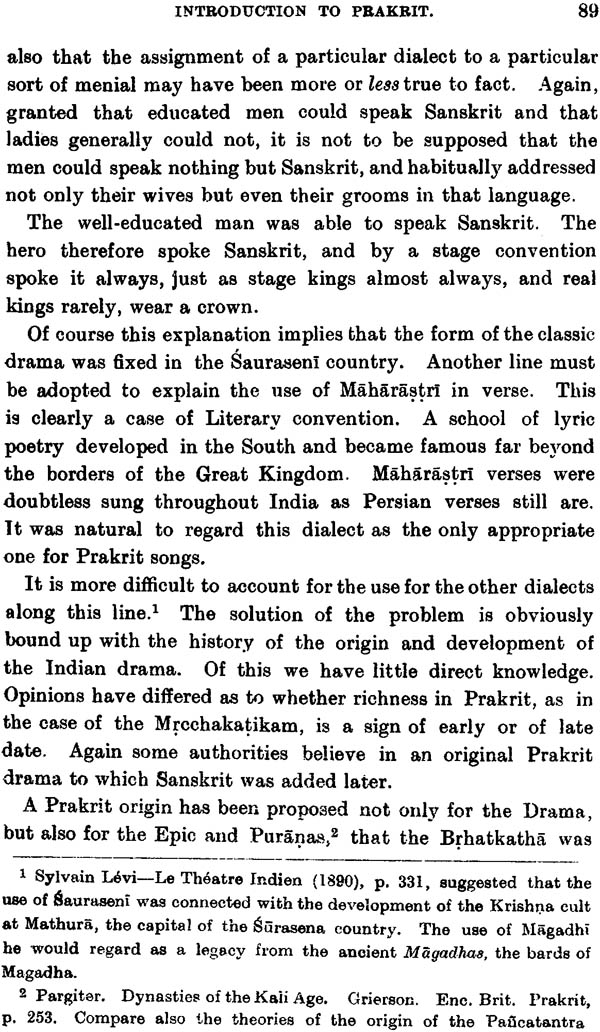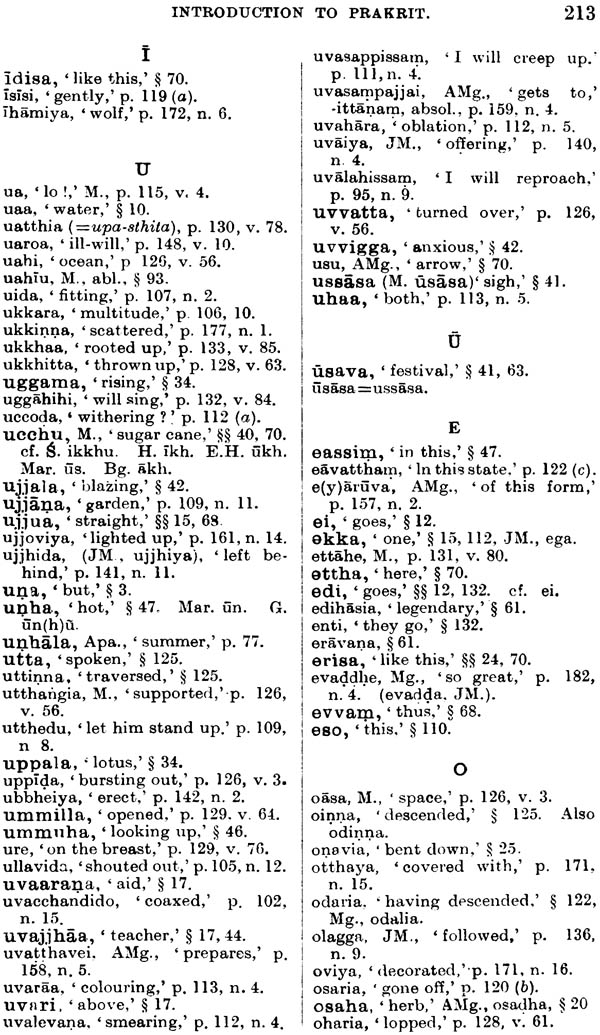
Introduction to Prakrit
Book Specification
| Item Code: | IDD562 |
| Author: | Alfred C. Woolner |
| Publisher: | MOTILAL BANARSIDASS PUBLISHERS PVT. LTD. |
| Language: | English |
| Edition: | 2008 |
| ISBN: | 9788120801899 |
| Pages: | 251 |
| Cover: | Paperback |
| Other Details | 8.5" X 5.3" |
| Weight | 330 gm |
Book Description
Introduction to Prakrit provides the reader with a guide for the more attentive and scholarly study of Prakrit occurring in Sanskrit plays, poetry and prose-both literary and inscriptional. It presents a general view of the subject with special stress on Sauraseni and Maharastri Prakrit system.
This book is divided into two parts. Part I consists of I-XI Chapter which deal with the three periods of Indo-Aryan speech, the three stages of the Middle Period, the literary and spoken Prakrits, their classification and characteristics, their system of Single and Compound Consonants, Vowels, Sandhi, Declension, Conjugation and their history of literature. Part II consists of a number of extracts from Sanskrit and Prakrit literature which illustrate different types of Prakrit – Sauraseni, Maharastri, Magadhi, Ardhamagadhi, Avanti, Apabhramsa, etc., most of which are translated into English.
The book contains valuable information on the Phonetics and Grammar of the Dramatic Prakrits – Sauraseni and Maharastri. It is documented with an Index as well as a Students’ Bibliography.
Degree courses in Sanskrit almost invariably include a Drama, of which a considerable portion is in I Prakrit. In practice, whatever Examiners may imagine, the student reads the Sanskrit chaya, which most editions provide for him on the same page. At any rate he begins that way; reading the Prakrit afterwards, noticing certain similarities, and some of the differences, so that he may be able to recognize a passage, with which he is already familiar in its Sanskrit form, and perhaps in an English translation. Even the more advanced student who reads the Prakrit as it comes; at the slightest check looks down at the shadow consequently few students have any definite knowledge of any one of the Prakrits. One cannot blame them. The editions they use are often incorrect in the Prakrit portions, and there is no convenient book of reference in which they can find definite rules. One object to this Introduction to Prakrit is to provide students with a guide for the more attentive and more scholarly study of the Saturaseni and Maharastri passages in their Sanskrit Plays.
The main object however is to assist the student of the History of the great Indo-Arayan Language from Vedic times to the present day. The Indian student starts with an intimate knowledge of at least one modern Indo-Aryan language. In the Sanskrit he learns at school, he becomes familiarized with the stereotyped literary form of the ancient language if he studies Sanskrit in the University, he will discover that the Vedic language represents a still more ancient stage of Indo-Aryan. For this there are accurate texts, and many works of reference available
The middle stage has been comparatively neglected. In India itself, the mediaeval Prakrits are in a more real sense dead languages, than is Sanskrit itself. Outside India scholars have found in Pali, the language of the oldest Buddhist Scriptures, a convenient representative of this stage. The student of Indo-Aryan Philology needs a clear view of the main characteristics of the different Prakrits. It is hoped that this work may prove useful for this purpose.
Method of Study.
Perhaps the best plan is to begin with the thorough study of one dialect, afterwards comparing others with this as a standard. This was the method of the Indian grammarians who took Maharastri as their standard. But the only prose extant in Maharastri was written by Jains and that not in the same dialect as the songs in the dramas. There are excellent aids to the study of Pali, but Pali is too archaic to make a good central point, and it is a separate subject in our curricula, and generally regarded as appropriate only to students of Buddhism. Moreover the Sanskrit student does actually first come into contact with Prakrit in the plays, and most of it is Sauraseni. For this, among other reasons, it has been thought desirable to present a general view of the subject, with special stress on Sauraseni and Maharastri.
The student making use of this book is advised to read the general sections, and to study the chapters on Phonetics and Grammar with special reference to the two main Dramatic Prakrits. The more important examples are printed in bold type and may be memorised. The Extracts 1 to 14 should then be thoroughly mastered, and the knowledge acquired applied to any play the student may be reading
The next step will be more philological, consisting in the comparison of the several stages and dialects as far as they are described in Chapters IV to X, and illustrated in Extracts 15 to the end.
The specimens of Pali and of old Prakrit are intended as inducements to further study. Modern forms have been occasionally quoted to should the historical continuity of words from ancient times. The student should be able to connect up a much larger number of forms from his mother tongue.
The Index is intended partly for convenience of reference, and partly to provide an instrument by which one may test one’s ability to explain forms, and to recognize them out of their context.
Transliteration.
The Roman script has been used for several reasons. Over a dozen years of teaching experience has convinced the writer that the slovenly spelling, so prevalent in both Roman and Devanagari scripts, is partly due to the fact that Hindi and Sanskrit are written in the same script, but with slightly different sound-values. A word written in Devanagari may be pronounced as in Sanskrit or as in Hindi, e.g. - bhagavan or as bhagvan., dharma or dharam, samaveda or samved and so on, Confusion is increased if the student has to distinguish a Prakrit pronunciation when the spelling is identical with that of a modern word. Another reason is that the Roman script being more atomic than Devanagari has advantages for stating phonetic laws in English.
Moreover any Indian student who aims at keeping abreast with modern scholarship should make himself thoroughly familiar with the use of this script. To make use of many books of reference, and Oriental Journals, it is almost as important to him, as Devanagari to the Western scholar.
These reasons seemed to outweigh the disadvantages of increased labour in proof—reading, and the initial feeling of un- familiarity with Sanskrit in this guise that may be experienced by the beginner.
On doubtful points, such as derivations where “Doctors disagree," the authority of Pischel has generally been followed. Controversy has generally been avoided, and where any reference has been made to rival theories or matters of dispute, it is only to suggest to the student fields of enquiry that still await his enterprise.
Apart from facilitating the study of the Indian Drama, and of Indian Philology, it is hoped that this little book may lead some of our students and graduates to take an interest in the great field of Indian thought and literature that lies outside the Sanskrit circle. » Without some knowledge of this, it is impossible to obtain an adequate idea of the life of mediaeval India.
The first edition was issued during the Great War. Proofs were read in intervals snatched from Civil and Military duties combined. In this second edition a number of misprints have been removed. In the meantime important contributions have been made to the history of the Indo-Aryan languages. The Chapters on Classification and Literature have been brought more up to date. Since this book first appeared there has been an increased interest in Prakrit in the Indian Universities and the general level of knowledge has risen. More attention is being given in several Universities to the history of the Indian languages. In view of this something has been said of Early Prakrit represented by Ashoka’s Inscriptions and late Prakrit represented by Apabhramsa.
For reading the proofs and seeing the second part through the press, I am much indebted to my friend and colleague, once a pupil, Dr. Banarsi Das Jain, M.A., Ph.D., now Lecturer in Hindi at the Oriental College, who has also made a number of useful suggestions.
About the Book:
Introduction to Prakrit provides the reader with a guide for the more attentive and scholarly study of Prakrit occurring in Sanskrit plays, poetry and prose - both literary and inscriptional. It presents a general view of the subject with special stress on Sauraseni and Maharastri Prakrit system.
The book is divided into two parts. Part I consists of I-XI Chapters which deal with the three periods of Indo-Aryan speech, the three stages of the Middle Period, the literary and spoken Prakrits, their classification and characteristics, their system of Single and Compound Consonants, Vowels, Sandhi, Declension, Conjugation and their history of literature. Part II consists of a number of extracts from Sanskrit and Prakrit literature which illustrate different types of Prakrit - Sauraseni, Maharastri, Magadhi, Ardhamagadhi, Avanti, Apabhramsa, etc., most of which are translated into English.
The book contains valuable information on the Phonetics and Grammar of the Dramatic Prakrits - Sauraseni and Maharastri. It is documented with an Index as well as a Students' Bibliography.
PREFACE
TABLE OF TRANSLITERATION
CHAPTER I: SUBJECT DEFINED.
Three periods of Indo-Aryan speech - Three stages of the middle period - Various uses of the word Prakrit
CHAPTER II: PRAKRITS
Enumeration of the more important literary Prakrits
CHAPTER III: GENERAL CHARACTER OF PRAKRIT.
Remains synthetic - Grammar simplified - Phonetic changes - assimilation - Parallel of Romance languages
CHAPTER IV. PHONETICS. SINGLE CONSONANTS.
A. Initial - B. Medial - C. Final
CHAPTER V: COMPOUND CONSONANTS
Assimilation - Two Mutes - Nasal and Mute - Mute and Sibilant - Semivowel and Mute - Two Nasals - Nasal and Sibilant - Nasal and Semivowels Sibilant and Semivowel - Two Semivowels - Svarabhakti
CHAPTER VI: VOWELS
Substitutes for r - for ai, au - Change of Quantity - Lengthening - Shortening - Vowel for Vowel - Omission of Vowels - Samprasarana - Epenthesis.
CHAPTER VII: SANDHI.
A. Consonants - Vowels
CHAPTER VIII: DECLENSION.
A Stems - I stems - U Stems - Feminine declension - Variants - R stems - AN stems - IN Stems - AT stems - S stems - Pronouns - Numerals
CHAPTER IX: CONJUGATION
Indicative - Imperative - Optative - Future - Passive - Causatives - Participles and Infinitive - Gerund - Irregualr Verbs - Past Participles - Irregular Indicatives - Irregualr Futures - Irregular Futures - Irregular Passives - Infinitives - Gerundives
CHAPTE X: CLASSIFICATION OF PRAKRITS
Magadhi - Dialects of Magadhi - Ardha Magadhi - Jain Maharastri - Jain Sauraseni - Geographical classification - Paisaci - Old Prakrit (Asokan, Pali, Asvaghosa) - Apabhramsa
CHAPTER XI: PRAKRIT LITERATURE
Jain Literature - Ardha Magadhi angas - Jain Maharastri - Kavya:- Setubandha - Gaudavaho - Hala - Dramatic Prakrits - Prakrit Grammars
| Extract No. 1. | Sauraseni. Ratnavali - (Dialogue) - Translation |
| Extract No. 2. | Sauraseni. Ratnavali - (The Picture) -Translation |
| Extract No. 3. | Sauraseni. Sakuntala - (Vidusaka) -Translation |
| Extract No. 4. | Sauraseni. Sakuntala - (Before the King) -Translation |
| Extract No. 5. | Sauraseni. Karpura manjari - (Heroine and Tunnel) |
| Extract No. 6. | Sauraseni. Same Play - (Puns) |
| Extract No. 7. | Sauraseni. Mrcchakatikam - (Scene with the child) |
| Extract No. 8. | Sauraseni. Same Play - (Jester admires the door) |
| Extract No. 9. | Maharastri. Verses from Sattasai of Hala. |
| Extract No. 10. | Maharastri. Five Songs from Sakuntala |
| Extract No. 11. | Maharastri. Three Verses from Mrcchakatikam |
| Extract No. 12. | Maharastri. Six Verses from the Camphor Cluster |
| Extract No. 13. | Maharastri. Ratnavali - One Song and Three Verses |
| Extract No. 14. | Maharastri. Setubandha - Building the Causeway - Rama's head - Sita's lament - Return to Ayodhya - Translation |
| Extract No. 15. | Jain Maharastri. Mandio the Robber -Translation |
| Extract No. 16. | Jain Maharastri. Domuha -King Doubleface -Translation |
| Extract No. 17. | Jain Maharastri. Kakkuka Inscription -Translation |
| Extract No. 18. | Jain Maharastri. Kalakacarya - Story of the Shahi -Translation |
| Extract No. 19. | Ardha-Magadhi. Udayana -Translation |
| Extract No. 20. | Ardha-Magadhi. Uvasagadasao - Saddalaputta the Potter -Translation |
| Extract No. 21. | Ardha-Magadhi. Kalpasutra - The King's Toilet -Translation |
| Extract No. 22. | Magadhi. Sakuntala. Fisherman and the Police |
| Extract No. 23. | Magadhi. Mrcchakatikam. Sthavaraka on the roof. |
| Extract No. 24. | Magadhi. Same Play. The King's brother-in-law |
| Extract No. 25. | Magadhi. Same Play. Sakari verses. |
| Extract No. 26. | Magadhi. Lalita-Vigraharaja. Two Tutushka Prisoners and a Spy. |
| Extract No. 27. | Avanti and Daksinatya. Mrcchakatikam. Viraka and Candanaka |
| Extract No. 28. | Pravacanasara |
| Extract No. 29. | Bhasa |
| Extract No. 30. | Early Prakrit. Asoka |
| Extract No. 31. | Pali. Jataka (308) |
| Extract No. 32. | Pali. Jataka (339) |
| Extract No. 33. | Pali. Mahavamsa |
| Extract No. 34. | Old Prakrit. Hathigumpha Inscription |
| Extract No. 35. | Late Prakrit. Apabhramsa |










INDEX AND EXAMPLES
STUDENTS' BIBLIOGRAPHY
Click Here For More Books on the Pali Language





